材料概论 材料科学概论 双语课件
- 格式:ppt
- 大小:6.49 MB
- 文档页数:73

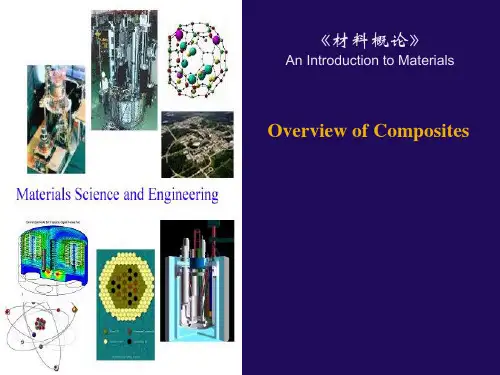
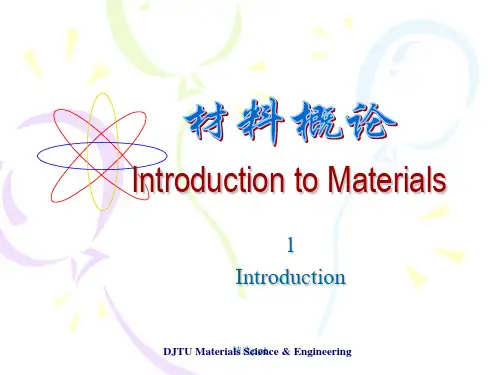
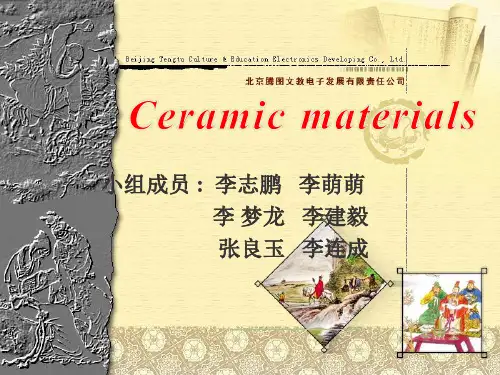
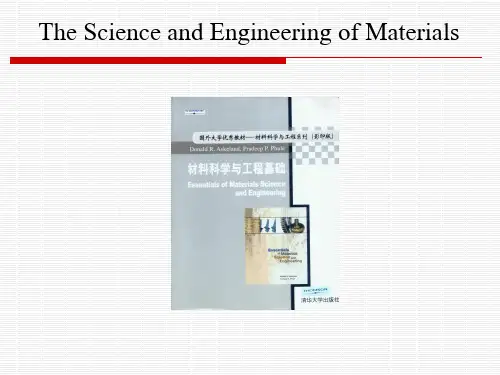
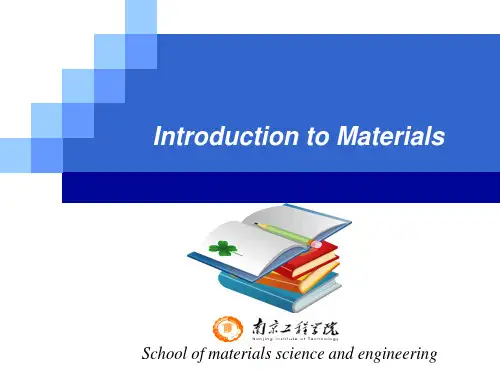

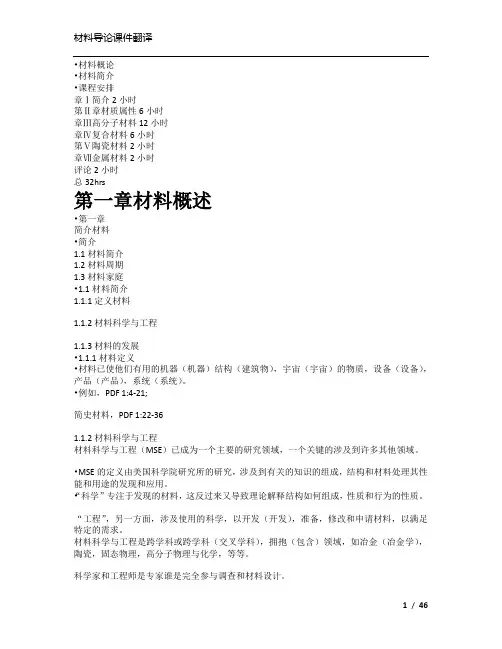
•材料概论•材料简介•课程安排章Ⅰ简介2小时第Ⅱ章材质属性6小时章Ⅲ高分子材料12小时章Ⅳ复合材料6小时第Ⅴ陶瓷材料2小时章Ⅶ金属材料2小时评论2小时总32hrs第一章材料概述•第一章简介材料•简介1.1材料简介1.2材料周期1.3材料家庭•1.1材料简介1.1.1定义材料1.1.2材料科学与工程1.1.3材料的发展•1.1.1材料定义•材料已使他们有用的机器(机器)结构(建筑物),宇宙(宇宙)的物质,设备(设备),产品(产品),系统(系统)。
•例如,PDF 1:4-21;简史材料,PDF 1:22-361.1.2材料科学与工程材料科学与工程(MSE)已成为一个主要的研究领域,一个关键的涉及到许多其他领域。
•MSE的定义由美国科学院研究所的研究,涉及到有关的知识的组成,结构和材料处理其性能和用途的发现和应用。
•“科学”专注于发现的材料,这反过来又导致理论解释结构如何组成,性质和行为的性质。
“工程”,另一方面,涉及使用的科学,以开发(开发),准备,修改和申请材料,以满足特定的需求。
材料科学与工程是跨学科或跨学科(交叉学科),拥抱(包含)领域,如冶金(冶金学),陶瓷,固态物理,高分子物理与化学,等等。
科学家和工程师是专家谁是完全参与调查和材料设计。
•为什么要研究材料科学与工程•要了解材料•要选择材料•设计材料•1.1.3材料的发展•材料飞机第一架飞机纯铝于1930的Al合金的开始1970 CC复合材料•材料成熟度曲线•1.2材料循环的制造商(制造业者)开始的原料如原油,天然气,树木,和棉花,以化学化合物,如乙烷,三氯甲烷,氟化氢,包括氯化乙烯。
从这些原料的单体(单分子)的生产和乙烯,甲基丙烯酸甲酯和氯乙烯。
•如果我们使总的材料循环效率,从而保护环境和自然资源,为子孙后代,我们必须制定正确的态度和习惯,在我们的公民(养成)。
•1.3材料家庭•聚合物1。
电气绝缘2。
保温3。
耐化学性4。
极轻的重量5。
透明度6。
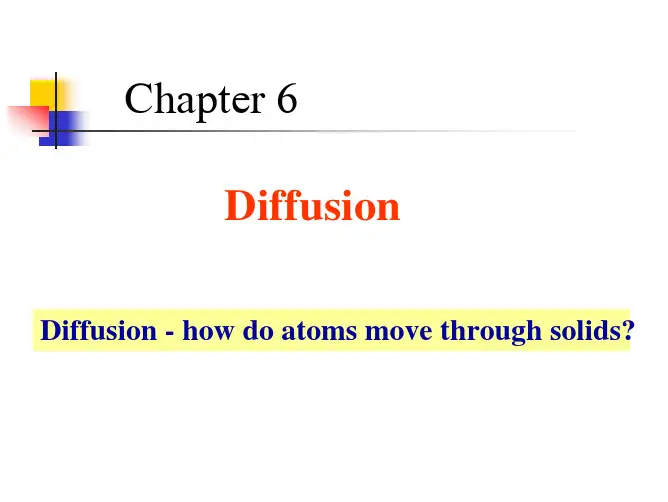
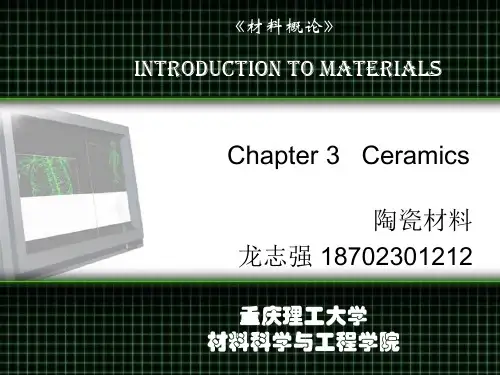
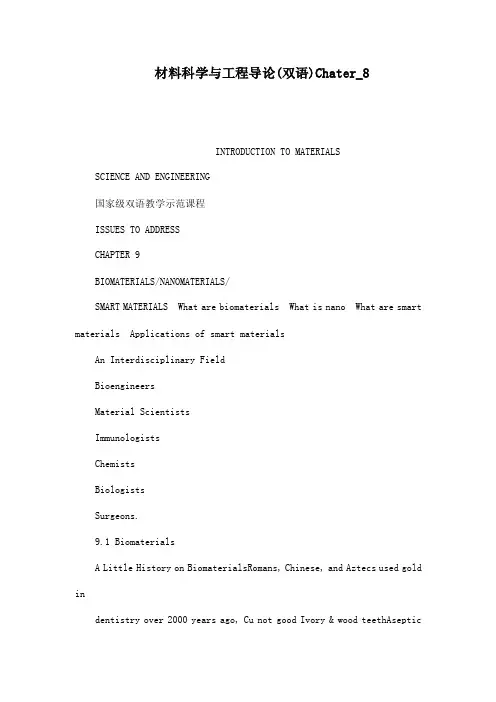
材料科学与工程导论(双语)Chater_8INTRODUCTION TO MATERIALSSCIENCE AND ENGINEERING国家级双语教学示范课程ISSUES TO ADDRESSCHAPTER 9BIOMATERIALS/NANOMATERIALS/SMART MATERIALS What are biomaterials What is nano What are smart materials Applications of smart materialsAn Interdisciplinary FieldBioengineersMaterial ScientistsImmunologistsChemistsBiologistsSurgeons.9.1 BiomaterialsA Little History on BiomaterialsRomans, Chinese, and Aztecs used gold indentistry over 2000 years ago, Cu not good Ivory & wood teethAsepticsurgery 1860 ListerBone plates 1900, joints 1930Turn of the century, synthetic plastics came intouseWWII, shards of PMMA unintentionally gotlodged into eyes of aviatorsParachute cloth used for vascular prosthesis1960- Polyethylene and stainless steel beingused for hip implantsWhat’s a biomaterial?1980 - Passive and inert point of viewAny substance or drugs, of synthetic or naturalorigin, which can be used for any period aloneor as part of a system and that increases orreplaces any tissue, organ or function of thebody.1990 ? Active point of viewNon-living material used in a medical deviceand designed to interact with biologicalsystems.Classification of BiomaterialsFirst generation: INERT Do not trigger any reaction in the host: neitherrejected nor recognition “ do not bring anygood result”Second generation: BIOACTIVE Ensure a more stable performance in a longtime or for the period you wantThird generation: BIODEGRADABLE It can be chemically degraded or decomposedby natural effectors weather, soil bacteria,plants, animalsMean Features for Medical ApplicationsBIOFUNCTIONALITY Playing a specific function in physical andmechanical termsBIOCOMPATIBILITY Concept that refers to a set of properties that amaterial must have to be used safely in abiological organism The ability of a material to perform with an appropriate host response in a specificapplication Host response: the reaction of a living system to the presence of a material.What is a biocompatible material?1 Synthetic or natural material used in intimatecontact with living tissue it can be implanted,partially implanted or totally external.2 Biocompatible materials are intended tointerface with biological system to EVALUATE,TREAT, AUGMENT or REPLACE any tissue,organ or function of the body A biocompatible device must be fabricated frommaterials that will not elicit an adverse biologicalresponse.Biocompatible material features1 Absence of carcinogenicity 致癌性 the abilityor tendency to produce cancer2 Absence of immunogenicity 致免疫性absence of a recognition of an external factorwhich could create rejection3 Absence of teratogenicity 致畸性 ability tocause birth defects4 Absence of toxicityWhat’s a bi odegradable implant Once implanted, should maintain its mechanical properties until it is no longerneeded and then be absorbed and excretedby the body, leaving no trace Biodegradable implants are designed to overcome the disadvantages of permanentmetal-based devices.BiomaterialsPolymeric biomaterialsBioceramicsMetallic biomaterialsBiocompositeBiologically based derived biomaterials Polymeric Biomaterials: Adv. & Disadv.聚甲基丙烯酸甲酯,俗称“有机玻璃”。
材料导论Introduction of Materials Science课程编号:07370130学分:2学时:30 (其中:讲课学时:30 实验学时:上机学时:)先修课程:大学英语、物理化学、材料科学基础适用专业:金属材料工程专业本科三年级学生教材:《Materials Scie nee〉J.C.A nderson 主编;Van Nostra nd Rei nhold Co. Ltd 第3版)开课学院:材料科学与工程学院一、课程的性质与任务《材料科学导论〉是金属材料工程专业教学计划中一门双语课程,它是学生上完大学英语和材料科学基础等课程以后开设的用英汉双语或英语讲授材料科学基础知识的课程。
是学生从学英语到把英语作为一种语言工具用于的专业学习中过渡,加强学生在英语学习中的听、说、读、写能力。
其主要任务是让学生掌握以下知识和能力:1. 掌握与材料科学有关的基本词汇和专业知识;2. 掌握用英语对材料科学的专业问题的表述能力;3. 掌握用英语阅读材料科学的书籍和专业文献的能力。
4. 掌握用英语进行专业写作的能力。
二、课程的内容及要求第一章Crystal structure1. 教学内容(1) Introduction,(2) Single Crystals(3) Interatomic distances and ionic radii(4) Close packed structures of identical spheres(5) Ironic crystals(6) Covalent crystals(7) Crystals with mixed bonding(8) Polymorphism第二章Crystal Defects(1) Introduction(2) Point defects(3) Line defects(4) Planar defects第三章Thermal Phenomena in Materials:(1) Introduction(2) Hard spheres 'model(3) The nature of thermal energy(4) Summary of the kinetics theory of mono atomic gas(5) Energy distributions(6) Thermal equilibrium(7) Thermodynamics(8) Mutiphase solids(9) Diffusion第四章Mechanical Properties(1) The stress-strain curve(2) Elatic deformation Atomic mechanism of elastic deformation(3) Plastic deformation(4) Strengthening mechanisms, Mechanic testing第五章Microstructure and Properties(1) Introduction(2) solid solutions and intermediate phases(3) Phase transformation(4) Some commercial alloy systems第六章Semiconductors第七章Magnetic Materials第八章Organic Polymers第九章Ceramics and Composites2. 基本要求(1)要求学生掌握本课程有关的材料科学的基本词汇;(2)要求学生具有用英语阅读专业书籍和文献的能力;(3)初步要求学生具有用英语口语进行专业问题的描述和讨论的能力(4)初步要求学生具有用英语进行专业写作的能力。